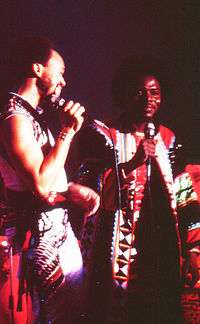Psychedelic soul
| Psychedelic soul | |
|---|---|
| Stylistic origins | |
| Cultural origins | Late 1960s, United States |
| Typical instruments |
|
| Derivative forms | |
| Fusion genres | |
| Funk rock | |
| Other topics | |
Psychedelic soul, sometimes called black rock,[1] is a subgenre of soul music, which mixes the characteristics of soul with psychedelia. It came to prominence in the late 1960s and continued into the 1970s, playing a major role in the development of funk and disco. Pioneering acts included Sly and the Family Stone and the Temptations. Mainstream acts that developed a psychedelic sound included the Supremes and Stevie Wonder. Acts that achieved notability with the sound included The Chambers Brothers, The 5th Dimension, Edwin Starr and George Clinton's Funkadelic and Parliament ensembles.
History
Origins
Following the lead of Jimi Hendrix in psychedelic rock, in the late 1960s psychedelia began to have a widespread impact on African American musicians, particularly the stars of the Motown label.[2] Influenced by the civil rights movement, it had a darker and more political edge than much psychedelic rock.[2] Building on the funk sound of James Brown, it was pioneered by Sly and the Family Stone with songs like "Dance to the Music" (1968), "Everyday People" (1968) and "I Want to Take You Higher" (1969), which had a sound that emphasized distorted electric rhythm guitar and strong basslines.[3] Also important were the Temptations and their producer Norman Whitfield, who moved from a relatively light vocal group into much more serious material with "Cloud Nine" (1968), "Runaway Child, Running Wild" (1969) and "Psychedelic Shack" (1969).[3]
Development
Other Motown acts soon followed into psychedelic territory, including established performers like the Supremes with "Reflections" (1967), "Love Child" (1968), and "Stoned Love" (1970).[4] Psychedelic influences could also be heard in the work of Stevie Wonder[2] and in Marvin Gaye's socially conscious work from What's Going On (1971).[5] Acts that broke through with psychedelic soul included The Chambers Brothers with "Time Has Come Today" (1966, but charting in 1968),[4] The 5th Dimension with a cover of Laura Nyro's "Stoned Soul Picnic" (1968),[4] Edwin Starr's "War" (1970) and the Undisputed Truth's "Smiling Faces Sometimes" (1971).[2]
George Clinton's interdependent Funkadelic and Parliament ensembles and their various spin-offs, took the genre to its most extreme lengths, making funk almost a religion in the 1970s. Influenced by Detroit rock groups including MC5 and The Stooges, they used extended distorted guitar solos and psychedelic sound effects, coupled with surreal imagery and stage antics, especially on early Funkadelic albums such as Funkadelic (1970), Free Your Mind... and Your Ass Will Follow (1970), and Maggot Brain (1971), and Parliament album Osmium (album) (1970),[1] producing over forty singles, including three in the US top ten, and three platinum albums.[6]
Decline and influence
While psychedelic rock began to waver at the end of the 1960s, psychedelic soul continued into the 1970s, peaking in popularity in the early years of the decade, and only disappearing in the late 1970s as tastes began to change.[2] Acts like Earth, Wind and Fire, Kool and the Gang and Ohio Players, who began as psychedelic soul artists, incorporated its sounds into funk music and eventually the disco which partly replaced it.[7]
Notable psychedelic soul artists


- Erykah Badu[8]
- Black Merda[9]
- The Chambers Brothers[2]
- The Chi-Lites[2]
- Earth, Wind & Fire[2]
- The 5th Dimension[4]
- The Friends of Distinction[2]
- Marvin Gaye[10]
- Jimi Hendrix[2]
- The Isley Brothers[2]
- Kool and the Gang[7]
- Funkadelic
- Mandrill[11]
- Curtis Mayfield[2]
- Buddy Miles[12]
- Janelle Monáe[13]
- Ohio Players[7]
- Shuggie Otis[2]
- Parliament-Funkadelic[2]
- Minnie Riperton[14]
- Rotary Connection[2]
- Sly & the Family Stone[2]
- Edwin Starr[2]
- The Supremes[4]
- The Temptations[2]
- The Undisputed Truth[2]
- War[15]
- Stevie Wonder[2]
See also
- Category:Psychedelic soul songs
- Psychedelic pop
- Neo-psychedelia
Notes
- 1 2 J. S. Harrington, Sonic Cool: the Life & Death of Rock 'n' Roll (Milwaukie, MI: Hal Leonard Corporation, 2002), ISBN 0-634-02861-8, pp. 249–50.
- 1 2 3 4 5 6 7 8 9 10 11 12 13 14 15 16 17 18 19 20 "Psychedelic soul", Allmusic, retrieved 27 June 2010.
- 1 2 R. Gulla, Icons of R&B and Soul: an Encyclopedia of the Artists who Revolutionized Rhythm, Volume 2 (London: Greenwood Publishing Group, 2008), ISBN 0-313-34046-3, pp. 278–81.
- 1 2 3 4 5 G. Case, Out of Our Heads: Rock 'n' Roll Before the Drugs Wore Off (Milwaukie, MI: Hal Leonard Corporation, 2010), ISBN 0-87930-967-9, pp. 70–1.
- ↑ J. Ankeny, "Marvin Gaye", Allmusic, retrieved 3 July 2010.
- ↑ V. Bogdanov, C. Woodstra and S. T. Erlewine, All Music Guide to Rock: the Definitive Guide to Rock, Pop, and Soul (Milwaukee, WI: Backbeat Books, 3rd edn., 2002), ISBN 0-87930-653-X, p. 226.
- 1 2 3 A. Bennett, Rock and Popular Music: Politics, Policies, Institutions (Abingdon: Routledge, 1993), ISBN 0-203-99196-6, p. 239.
- ↑ Caramanica, Jon (September 24, 2003). "Erykah Badu". Rolling Stone, retrieved 3 June 2014.
- ↑ S. Huey and J. Bush, "Black Merda", Allmusic, retrieved 3 July 2010.
- ↑ J. Ankenyhttp, "Marvin Gaye", Allmusic, retrieved 3 July 2010.
- ↑ S. Huey, "Mandrill", Allmusic, retrieved 3 July 2010.
- ↑ S. Huey, "Buddy Miles", Allmusic, retrieved 3 July 2010.
- ↑ Martens, Todd (March 19, 2009). "SXSW Day 2 afternoon report: Get to know Janelle Monae". Los Angeles Times, retrieved 12 May 2013.
- ↑ J. Ankeny, "Minnie Riperton", Allmusic, retrieved 3 July 2010.
- ↑ V. Bogdanov, C. Woodstra and S. T. Erlewine, All Music Guide to Rock: the Definitive Guide to Rock, Pop, and Soul (Milwaukee, WI: Backbeat Books, 3rd edn., 2002), ISBN 0-87930-653-X, p. 1206.